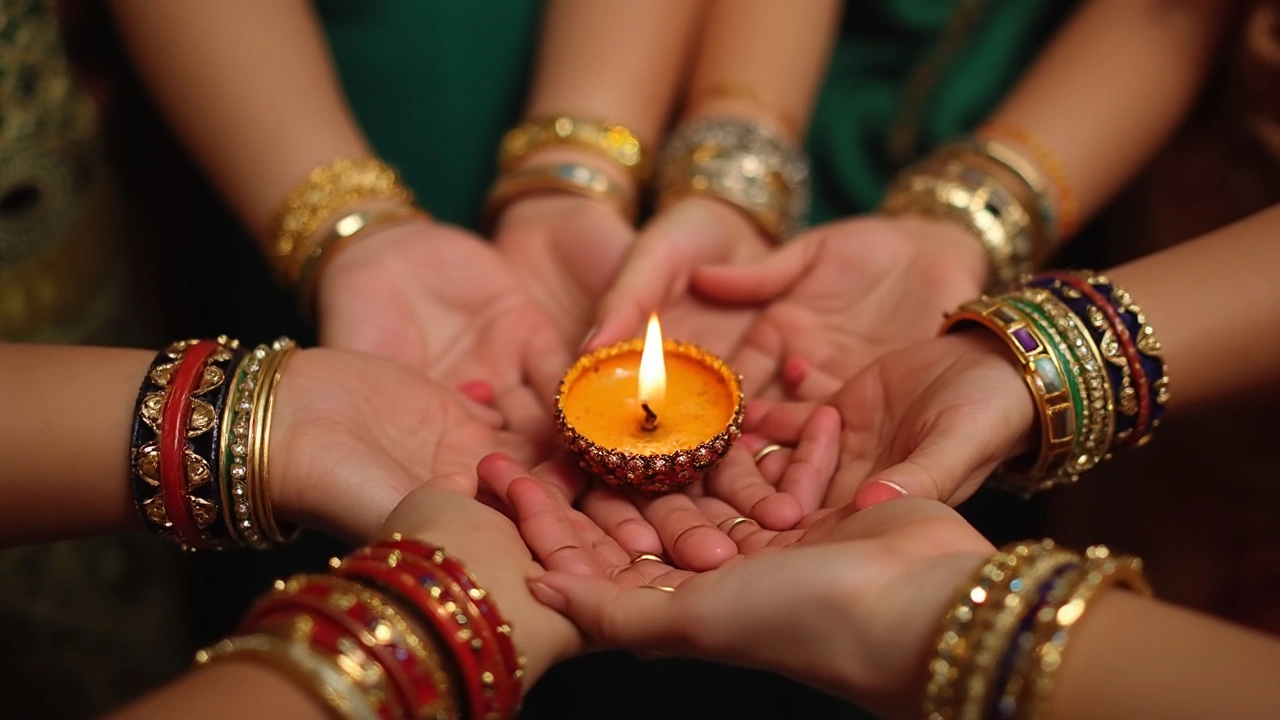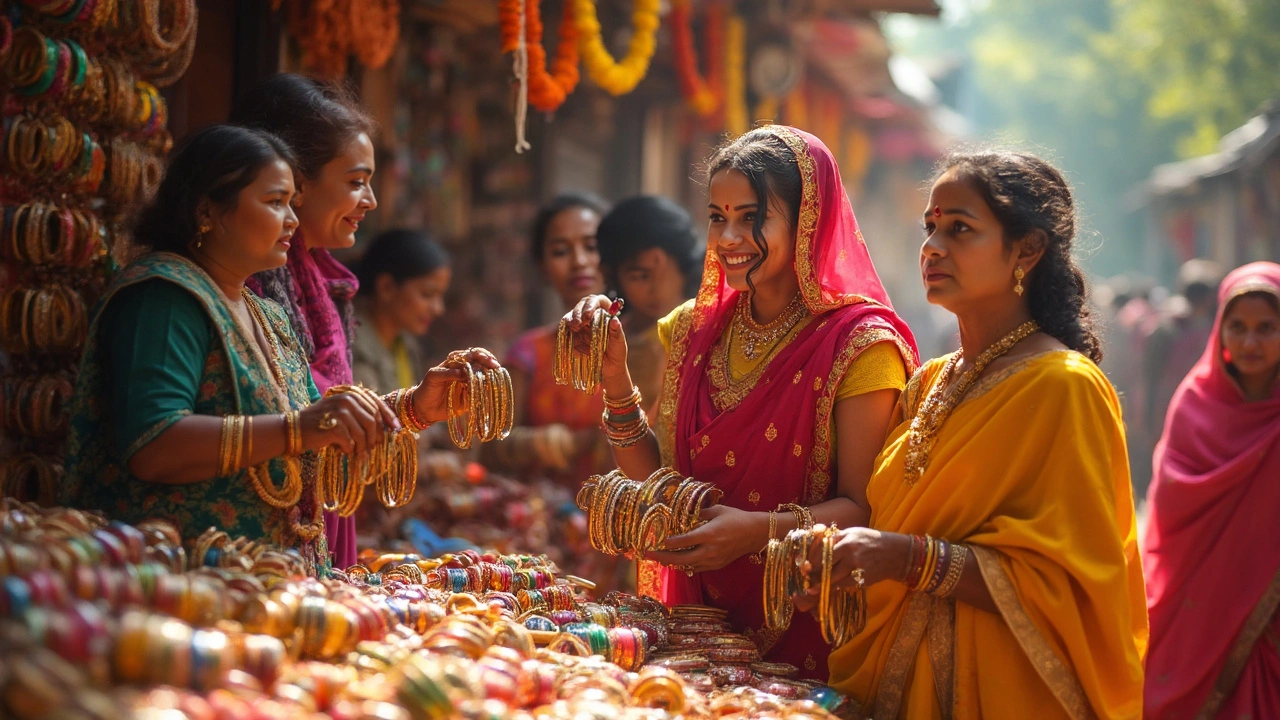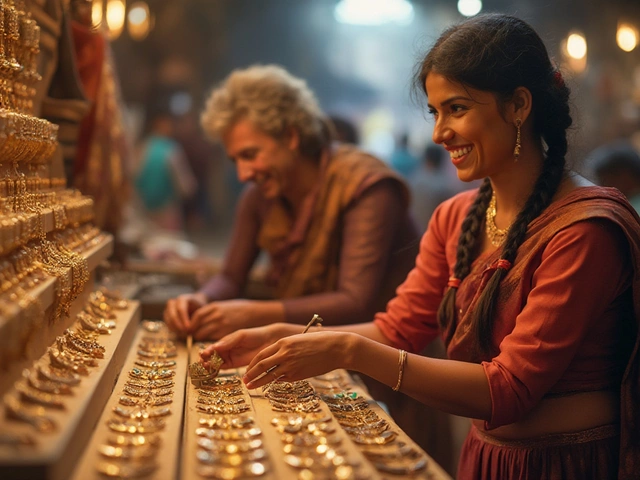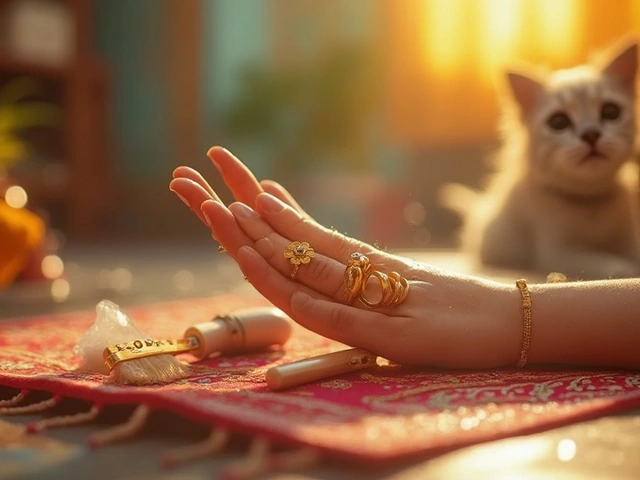If you ask almost any Indian woman what her first bangle memory is, chances are it’s tied to childhood or that first big family wedding. Around here, bangles aren’t just fancy wrist accessories—they’re part of who we are. Every family, every region, even every festival has its own slang, myth, and story about bangles. These stories aren’t just old wives’ tales either; there’s real history layered beneath all that color and clinking sound.
Walk through any traditional market in India and you’ll see rows of bangles: glass, gold, silver, lacquer, metal, plastic—take your pick. They’re everywhere, from roadside stalls in Rajasthan to the popular Laad Bazaar in Hyderabad. Some women never leave home without them, especially after marriage. There’s a popular belief that wearing bangles brings good luck, health, and boosts positive energy. Sounds superstitious? Maybe. But when you watch my cousin stacking green glass bangles before her engagement, you can’t help but get pulled into the excitement.
- The Deep Roots of Bangles in Indian Culture
- Meanings and Traditions Around Bangles
- Different Kinds and What Makes Each Special
- Tips to Pick, Wear, and Care for Bangles
The Deep Roots of Bangles in Indian Culture
Bangles go way back—archaeologists found bangle-like ornaments in Mohenjo-Daro that are more than 4500 years old. That’s older than most of the cities in Europe! Back then, they made these wristbands out of terracotta, copper, and shells. Fast-forward to today, and they’re in every wedding, festival, and market all over the country.
Across India, bangles stand for more than decoration. For married women, they’re almost like a badge of honor. Some regions even say that if a woman’s bangles break, it’s bad luck. It’s no joke; breakage brings on collective gasps in older relatives. In Punjab, you’ll see new brides wearing ivory ‘chooda’ bangles, while in Bengal, white and red ‘shakha-pola’ bangles mark marriage. Down south, gold bangles often get passed from mother to daughter. Each state has its quirks, but the love for bangles is everywhere.
Here’s a neat table showing traditional bangle trends in different parts of India:
| State/Region | Traditional Bangle Type | Material | Special Meaning |
|---|---|---|---|
| Punjab | Chooda | Ivory, Plastic | Worn by new brides |
| Bengal | Shakha-Pola | Conch/Coral | Sign of marriage |
| Maharashtra | Patlya & Tode | Gold | Gifted at marriage, signifies good luck |
| South India | Valayal | Gold/Glass | Passed down by elders |
| Rajasthan | Lac Bangles | Lacquer | Worn in festivals and weddings |
Bangles are everywhere you look—Bollywood movies, family photos, marketplaces. My mom says when she hears the clinking sound as Anaya plays dress-up, it brings back memories of her own childhood. This mix of nostalgia and tradition is what keeps bangles, especially traditional bangles india, a big deal in our homes.
Meanings and Traditions Around Bangles
Bangles aren’t just jewelry—they’ve got real meaning in Indian life. For married women, especially in North India, wearing red and green glass bangles is considered a must. It’s a way to signal to the world that you’re married, just like the mangalsutra. In some cultures, breaking all your bangles at once is seen as bad luck, especially for married women. No one wants that, so my mom still has a habit of carefully storing her sets every night.
At weddings, brides go big on bangles. Punjabi brides wear special ivory and red bangles called chooda, often given by the bride’s maternal uncle. Down south in Tamil Nadu, bangles made of gold and glass are part of a pre-wedding ceremony called Valaikaapu, which is held during pregnancy for good luck, health, and protection for the mom and the baby.
It’s wild, but in some parts of India, tradition says the sound of bangles can keep away negative vibes and even evil spirits. Elders say the tinkling sound acts like a positive energy shield. One common advice I heard growing up is, "Don’t wear broken bangles. Replace them soon or it’s unlucky." Honestly, almost every Indian home has this rule.
“The tradition of bangles in Indian culture is not just decorative but symbolic; they represent life, prosperity, and societal status.” — Dr. Ruchika Sharma, historian
Bangles even play a part in festivals like Karva Chauth, Teej, and Raksha Bandhan. On these days, women wear new bangles for their rituals—sometimes even exchanging them as a friendly gesture. For kids, getting their first set of tiny bangles is a big deal in most families. I remember Anaya’s first gold bangle—her grandmom brought it all the way from Kerala.
Check out this quick table with some unique bangle traditions across India:
| Region | Type of Bangle | Occasion/Belief |
|---|---|---|
| Punjab | Chooda (ivory & red) | Gifted at weddings by uncle |
| Bengal | Shakha Pola (conch shell & red coral) | Marriage, for long life of husband |
| Maharashtra | Green glass bangles | Married women, symbol of fertility |
| South India | Gold, glass bangles | Valaikaapu during pregnancy |
You start to see why traditional bangles india are still so important. Whether it’s for marking stages of life, bringing good vibes, or just sticking to family routines, bangles are loaded with meaning in ways you never really outgrow.

Different Kinds and What Makes Each Special
Indian bangles come in more flavors than a sweet shop, and each one has its own story. If you’re thinking of spicing up your collection, you’re bound to stumble upon something new every time you visit a market or scroll through Instagram. The real deal about bangles is how much they reflect where you’re from, which community you belong to, and sometimes what phase of life you’re in.
First up, glass bangles. These are easily the most recognizable style, especially in places like Hyderabad and Firozabad. Married women in Maharashtra are known for stacking green glass bangles, while women in Punjab and Gujarat will go bold with red or ivory shades for weddings. Glass bangles are loved for their budget-friendly price and that satisfying clinking sound everyone secretly enjoys.
If you see someone showing off bright red and white bangles, you’re probably looking at a Punjabi bride in her wedding “chooda.” These are made from plastic or ivory, and wearing them isn’t just about looks—tradition says they bring luck and happiness to a new marriage.
Metal bangles, also called “kadas,” don’t have the same delicate vibe but are super durable. In Sikhism, the steel kada is actually a religious symbol, not just a style statement. And gold bangles? Those are an investment for life, passed from mom to daughter as a sort of “family heritage” package. During festivals like Diwali, you’ll see gold bangles being gifted as a way of wishing prosperity and good times.
Lac bangles from Rajasthan and Hyderabad are worth checking out if you want something artsy and traditional. These come packed with intricate designs, stones, and bright colors. Handmade by craftsmen, they speak volumes about local culture and skill.
In South India, bangle designs get even more interesting. Temple jewelry bangles are inspired by old carvings and deities. They’re chunkier, often with gold plating and semi-precious stones, perfect for festivals and big events.
- Glass bangles – cheap, colorful, and perfect for day-to-day wear
- Wedding chooda – red and white, tied to Punjabi marriage rituals
- Metal and gold bangles – durable, symbolic, or even spiritual
- Lac bangles – artisan-made, local to Rajasthan/Hyderabad
- Temple jewelry – bold, inspired by South Indian gods and goddesses
No matter which type you pick, traditional bangles India aren’t just decoration. Each style packs its own meaning, roots, and a dash of local attitude. It’s not just about looking good; it’s about telling your own story.
Tips to Pick, Wear, and Care for Bangles
Shopping for bangles can be confusing thanks to the endless choices. My wife, Pooja, never forgets to check the make and fit before buying a new pair. Here’s what I’ve learned tagging along with her on those countless bangle hunts:
- Traditional bangles India options are wide: from gold and silver for formal events to glass and plastic for casual wear. Gold bangles, according to the India Bullion & Jewellers Association, rose in price by around 14% in 2024, turning them into even bigger investments for many families.
- Size matters. Bangles are sized in inches and must be snug but shouldn’t hurt. Try sliding a bangle over folded fingers but make sure it doesn’t squeeze your wrist too tight. Kids like my daughter Anaya always need their size checked as their wrists grow fast.
- Match wisely. For daily wear, glass or copper are less fussy. For weddings, gold or lacquer wins. Color choices often depend on the occasion. Red and green are classic at South Indian weddings, while Maharashtrian brides go for green glass sets. Mixing metals or textures creates a modern twist.
- Check craftsmanship. Smooth edges, a uniform finish, and sturdy material mean better comfort and durability. Knock off a glass bangle gently—the clear ring means it’s well-made, while a dull sound hints at poor quality.
“A woman’s trousseau feels incomplete without a solid set of bangles. It’s not just decor; it’s about tradition and continuity,” says jewelry designer Ritu Kumar in a 2023 Vogue India interview.
Now, let’s talk care. Bangles get scratched and lose shine if you ignore them. Here’s a quick routine that works for us at home:
- Keep heavy and delicate bangles separate to avoid scratches.
- For glass bangles, wrap them in soft cloth when storing. Gold ones? Wipe gently with a microfibre cloth—avoid harsh chemicals, which can dull the shine permanently.
- Never wear metal bangles while washing dishes or gardening—soapy water and mud do a lot of damage over just a few months.
Curious how long each type lasts? Take a look at this quick breakdown:
| Type | Average Lifespan | Care Needed |
|---|---|---|
| Gold | 20+ years | Low, gentle cleaning |
| Silver | 10-15 years | Regular polishing |
| Glass | 1-3 years | High, careful storage |
| Copper/Metal | 5-10 years | Occasional polishing |
If you want bangles that make heads turn but last through all the daily chaos, picking quality and following these simple habits is all it takes.



